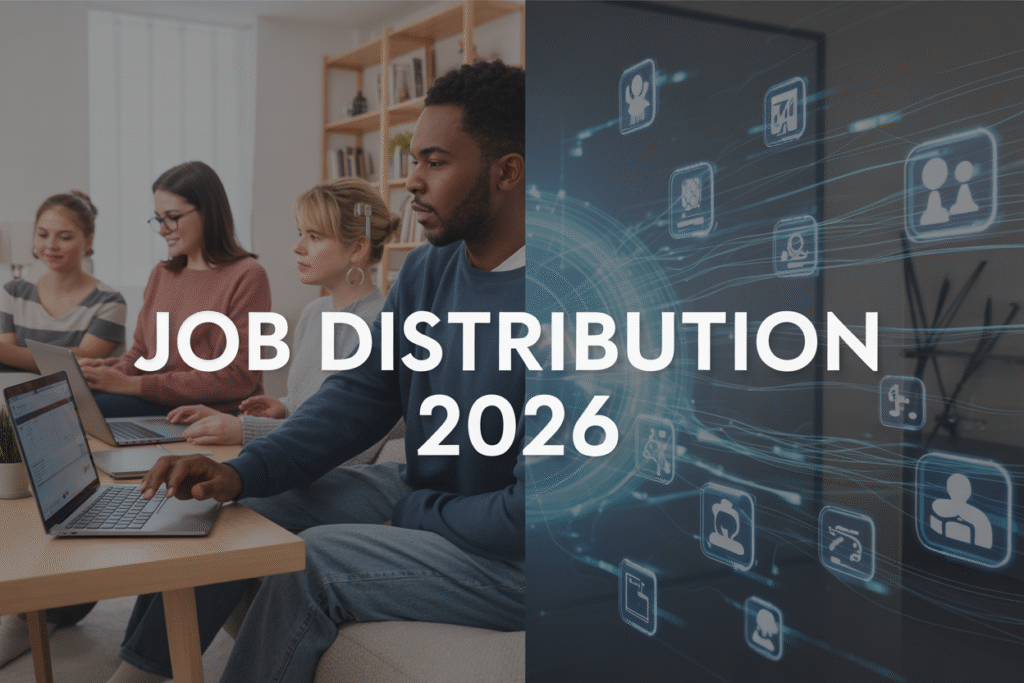What’s Next? Upcoming Trends in Job Distribution for 2026

The job market is changing fast, and job distribution trends in 2026 will look completely different from what we see today. Suppose you’re a job seeker, HR professional, career counselor, or business leader trying to stay ahead of the curve. In that case, understanding these shifts is crucial for making smart decisions about your future.
The way companies find talent and workers find jobs is getting a significant makeover. Remote work isn’t just a pandemic leftover anymore—it’s reshaping entire career landscapes and changing where opportunities pop up. At the same time, AI recruitment technology is making job matching smarter and faster than ever before.
We’ll explore how the evolution of remote work is creating new geographic patterns for talent distribution and opening doors that were previously closed by location. Then we’ll dive into how AI-powered job matching algorithms are transforming recruitment from a guessing game into a precise science. Finally, we’ll examine the explosive growth of the gig economy and how skills-based hiring is replacing traditional degree requirements, creating more flexible paths to career success.
These changes aren’t just coming—they’re already here. Let’s break down what they mean for your career or business strategy.
Remote Work Evolution Reshaping Career Landscapes
Hybrid Workplace Models Becoming the New Standard
The traditional 9-to-5 office setup is rapidly becoming a relic of the past. By 2026, hybrid workplace models will dominate the employment landscape, with companies offering 2-3 days of in-office work and the remainder of the workweek remote. This shift isn’t just about employee preference—it’s driven by measurable productivity gains and cost savings for employers. Organizations are discovering that flexible arrangements lead to better talent retention, reduced overhead costs, and access to a broader talent pool.
Major tech companies, such as Microsoft and Google, have already committed to permanent hybrid structures, setting a precedent for other industries to follow. These flexible employment models are reshaping how we think about workspace design, team collaboration, and performance measurement. Companies are investing in hot-desking systems, advanced booking platforms, and redesigned office spaces that prioritize collaboration over individual workstations.
Geographic Boundaries Dissolving for Talent Acquisition
The concept of hiring locally is becoming obsolete. Workforce distribution patterns are shifting dramatically as companies realize they can access top talent regardless of location. A software engineer in rural Montana can now work for a Silicon Valley startup, while a marketing specialist in Poland contributes to a New York-based agency.
This geographic flexibility is creating a more equitable job market where opportunities aren’t concentrated in expensive metropolitan areas. Companies are expanding their search radius globally, leading to adjustments in salaries and the development of new compensation models that account for cost-of-living differences. Remote-first organizations are establishing “salary bands” based on role complexity rather than location, though regional variations still exist.
The evolving career landscape includes new considerations such as time zone management, cultural integration, and international employment law compliance. HR departments are adapting their processes to handle cross-border hiring, tax implications, and varying labor regulations.
Digital Nomad Roles Expanding Across Industries
Digital nomadism is evolving beyond freelance writing and web development. Traditional industries, such as finance, healthcare, and manufacturing, are creating location-independent positions. Customer service representatives work from Bali, financial analysts operate from co-working spaces in Mexico City, and project managers coordinate teams while traveling through Europe.
Companies are establishing “nomad-friendly” policies that include travel stipends, co-working space memberships, and flexible time zone requirements. Some organizations offer “workations” where entire teams relocate temporarily to different cities or countries. This trend is driving the growth of digital nomad visas in countries like Portugal, Estonia, and Barbados, which actively court remote workers.
The infrastructure supporting digital nomads is expanding rapidly. Co-working chains like WeWork and Spaces now operate globally, while new platforms connect nomadic professionals with temporary housing and local networking opportunities.
Virtual Collaboration Tools Driving Productivity Gains
The technology powering remote work trends has matured significantly. Advanced virtual reality meeting platforms are replacing traditional video calls, creating immersive experiences that closely mimic in-person interactions. AI-powered scheduling tools automatically coordinate meetings across time zones, while project management platforms provide real-time visibility into team progress.
Productivity tracking has become more sophisticated, focusing on outcomes rather than the number of hours worked. Tools like Notion, Slack, and Asana have integrated AI features that predict project bottlenecks and suggest resource reallocation to optimize workflow. Companies report 15-25% productivity increases when using comprehensive digital collaboration suites.
The emergence of “digital body language” training helps remote workers communicate more effectively through written channels. Organizations are investing in the development of communication skills, recognizing that remote success depends heavily on clear and concise digital interaction. This shift is creating new training opportunities and specialized consulting services focused on virtual team dynamics.
AI-Powered Job Matching Revolutionizing Recruitment
Machine learning algorithms are improving candidate-role compatibility.
AI recruitment technology is transforming how companies match candidates with perfect-fit positions. Advanced algorithms now analyze thousands of data points beyond traditional resumes – from coding patterns to communication styles – creating compatibility scores that human recruiters can’t match. These systems examine work samples, assess personality traits through behavioral analytics, and even evaluate cultural alignment with company values.
The beauty lies in continuous learning. Each successful hire teaches the algorithm what works, refining future recommendations. Companies report 40% better retention rates when using AI-powered matching systems compared to traditional hiring methods. The technology goes deeper than keyword matching, understanding context and nuance in candidate profiles while identifying transferable skills that humans might overlook.
Predictive analytics identifying future skill demands
Innovative recruitment platforms are becoming crystal balls for workforce planning. By analyzing industry trends, job posting patterns, and emerging technologies, these systems predict which skills will be in demand 6 to 12 months ahead. This foresight helps companies prepare for future hiring needs and guides candidates toward valuable skill development.
The algorithms track everything from GitHub commits to LinkedIn course completions, enabling the building of real-time skill demand forecasts. Companies can now identify talent gaps before they become critical, while job seekers gain insights into which certifications will boost their marketability. This predictive approach is reshaping the evolution of the career landscape, helping both sides of the hiring equation stay ahead of market changes.
Automated screening processes reduce hiring timelines
Recruitment automation is slashing time-to-hire from weeks to days. AI-powered screening tools conduct initial candidate assessments 24/7, evaluating technical skills through coding challenges, analyzing video interviews for communication abilities, and scoring cultural fit through personality assessments. This eliminates scheduling bottlenecks and accelerates the entire hiring pipeline.
The screening process has become incredibly sophisticated, using natural language processing to evaluate written responses and computer vision to assess non-verbal communication. Companies report 60% faster hiring cycles while maintaining or improving hire quality. These automated systems also reduce unconscious bias by focusing on objective performance metrics rather than subjective impressions, thereby creating fairer opportunities for all candidates in the evolving job market landscape of 2026.
Gig Economy Expansion Creating Flexible Career Pathways
Specialized Freelance Platforms Emerging in Niche Markets
The freelance landscape is splintering into highly specialized ecosystems as niche platforms gain momentum. Traditional broad-spectrum sites are giving way to focused marketplaces serving specific industries, such as biotech research, sustainable architecture, or blockchain development. These platforms offer deeper expertise matching and industry-specific tools that generic sites can’t provide.
Healthcare freelance platforms now connect hospitals with specialized nurses for temporary assignments, while fintech platforms pair startups with regulatory compliance experts. Creative industries are seeing platforms dedicated to motion graphics for streaming services or AR/VR content creation. This specialization creates better matches between client needs and freelancer skills, driving higher satisfaction and premium pricing for specialized talent.
Project-Based Employment Replacing Traditional Full-Time Roles
Companies are restructuring their workforce around project cycles rather than permanent positions. Tech giants now hire engineering teams for specific product launches, disbanding them once objectives are met. Marketing departments operate with core staff supplemented by project-based specialists for campaigns.
This shift reflects changing business needs where companies require different skill sets at different times. A startup might need blockchain developers for six months, then pivot to AI specialists. Project-based employment allows organizations to access top-tier talent without long-term commitments, while professionals can work on diverse, challenging projects across multiple industries.
Multi-Income Stream Careers Becoming Mainstream
The traditional single-employer model is dissolving as professionals embrace portfolio careers. Data scientists might consult for startups, teach online courses, and develop AI tools simultaneously. Marketing professionals combine agency work with personal brand building and affiliate partnerships.
This approach provides financial security through diversification, allowing professionals to explore various interests. Many report higher job satisfaction when they can balance analytical work with creative projects, or combine remote consulting with local community involvement. The rise of digital payment systems and project management tools makes managing multiple income streams increasingly feasible.
Corporate Adoption of Flexible Workforce Models
Enterprise organizations are revolutionizing their staffing strategies by building hybrid workforces combining full-time employees with flexible talent pools. Major corporations now maintain “talent clouds” – networks of vetted freelancers and contractors they can activate quickly for specific projects or seasonal demands.
This model allows companies to scale rapidly without the overhead of permanent hires. During product launches, they can instantly access specialized marketing talent, design experts, and technical writers. Retail companies use flexible models for holiday staffing, while consulting firms expand their expertise by partnering with independent specialists.
Independent Contractor Protections Strengthening
Legal frameworks are evolving to protect gig workers while preserving employment flexibility. New regulations address healthcare access, retirement planning, and professional development for independent contractors. Several states are implementing portable benefits systems that travel with workers across different platforms and projects.
Professional associations for freelancers are gaining influence, providing collective bargaining power and standardized contract templates. Insurance products tailored for gig workers are emerging, covering gaps in traditional employer-provided benefits. These protections make independent work more attractive and sustainable as a long-term career choice.
Skills-Based Hiring Overtaking Degree Requirements
Competency assessments replacing educational credentials
Traditional hiring practices built around degree requirements are cracking under pressure as companies realize that academic credentials don’t always translate to real-world performance. Progressive organizations are now implementing practical competency assessments that evaluate candidates based on their actual ability to solve problems and deliver results. These assessments range from coding challenges for developers to design sprints for creative professionals, giving employers a clearer picture of what candidates can actually accomplish.
The shift makes perfect sense when you consider how many successful professionals learned their craft through non-traditional paths. Self-taught programmers often outperform computer science graduates in practical scenarios. At the same time, experienced marketers who built their expertise through hands-on campaigns frequently demonstrate deeper strategic thinking than those with marketing degrees but limited experience.
Skills-based hiring is becoming particularly prominent in technology, where companies like Google, IBM, and Apple have already dropped degree requirements for numerous positions. This trend reflects the growing recognition that talent exists everywhere, regardless of educational background, and that practical skills matter more than institutional credentials when predicting job success.
Micro-credentials and digital badges are gaining employer recognition
Digital credentials are transforming how professionals showcase their expertise, with micro-credentials and specialized certificates gaining serious traction among forward-thinking employers. These focused learning achievements demonstrate specific competencies without requiring years of traditional education, making them perfect for today’s rapidly evolving job market.
Platforms like Coursera, LinkedIn Learning, and industry-specific providers are issuing badges that carry real weight in hiring decisions. A cybersecurity professional might earn a CompTIA certification, while a digital marketer could pursue Google Analytics credentials – both demonstrating targeted expertise that employers value more than generic degrees.
What makes these credentials particularly powerful is their recency and specificity. Unlike a degree earned years ago, microcredentials typically reflect current knowledge and skills acquired recently. They also allow professionals to build customized skill portfolios that align with specific job requirements rather than following broad academic programs that might include irrelevant coursework.
Real-time skill verification through portfolio demonstrations
The traditional interview process is evolving into dynamic skill demonstrations where candidates prove their abilities through live work samples and portfolio presentations. This approach provides both parties with a realistic preview of the working relationship, thereby reducing hiring mismatches and enhancing job satisfaction rates.
Software developers now commonly participate in pair programming sessions during interviews, while designers present case studies and walk through their creative process. Marketing professionals might analyze campaign data or propose strategies for real business challenges, demonstrating their analytical and strategic thinking abilities.
Portfolio-based hiring works particularly well for creative and technical roles where output quality speaks louder than credentials. A graphic designer’s portfolio tells a more compelling story than their degree, just as a writer’s published work demonstrates their abilities more effectively than their academic transcript.
Career transitions are accelerating through skill transferability
The emphasis on skills over formal qualifications is making career pivots more accessible and less risky for professionals seeking new directions. People can now transition between industries by highlighting transferable skills and demonstrating relevant competencies, rather than requiring additional education.
Project management skills translate across virtually every industry, while data analysis capabilities are valuable whether you’re in finance, healthcare, or retail. Communication and problem-solving abilities remain relevant across all sectors, enabling professionals to reframe their experience for new opportunities.
This flexibility is creating more fluid career landscapes where professionals can follow their interests and market opportunities without being trapped by their educational background. The result is a more dynamic workforce where skills-based hiring enables both personal growth and organizational innovation.
Industry-Specific Distribution Shifts Emerging
Healthcare and eldercare sectors are experiencing massive growth
The aging population across developed nations is creating an unprecedented demand for healthcare professionals and caregivers for the elderly. By 2026, these sectors are expected to dominate workforce distribution patterns, with nursing, home health aide, and specialized medical roles leading the way. The job growth extends beyond traditional healthcare settings into innovative areas, such as telehealth coordination, medical technology specialists, and wellness program management.
Elder care presents explicitly unique opportunities as baby boomers require specialized services. Positions in memory care, physical therapy assistance, and companion care are multiplying rapidly. Remote patient monitoring roles and digital health coordinators are also emerging as technology becomes increasingly integrated into healthcare delivery systems.
Green energy and sustainability roles are multiplying rapidly
Climate initiatives and government mandates are driving explosive growth in environmental careers. Solar panel technicians, wind turbine specialists, and energy efficiency consultants are becoming hot commodities in the job market. The push toward carbon neutrality is creating entirely new career paths that didn’t exist five years ago.
Corporate sustainability roles are expanding beyond traditional environmental consulting. Companies now need ESG reporting specialists, carbon footprint analysts, and sustainable supply chain managers. The development of electric vehicle infrastructure alone is generating thousands of positions for engineers, technicians, and project managers. Green building certification professionals and renewable energy project coordinators are experiencing robust demand.
Cybersecurity positions are expanding across all sectors
Digital transformation, accelerated by recent global events, has made cybersecurity a concern for everyone.Small businesses, healthcare facilities, educational institutions, and government agencies all need protection from increasingly sophisticated cyber threats. This universal need is creating job opportunities across every industry imaginable.
The roles go far beyond traditional IT security. Organizations require cybersecurity awareness trainers, incident response specialists, and compliance officers who possess a comprehensive understanding of both technology and regulatory requirements. Cloud security architects and IoT security specialists are particularly sought after as businesses embrace new technologies. Even marketing teams now require professionals who understand data privacy regulations and secure customer communications.
Creative and content creation jobs are proliferating digitally.
The creator economy has exploded into a legitimate career pathway, with brands recognizing the power of authentic content marketing. Video editors, social media strategists, and podcast producers are finding steady employment opportunities both as freelancers and full-time employees. Live streaming coordinators and community managers are becoming increasingly essential roles for businesses that engage with digital audiences.
User-generated content specialists help brands collaborate with influencers and manage campaigns across multiple platforms. Digital storytelling roles combine traditional creative skills with platform-specific expertise. Companies are hiring dedicated TikTok managers, YouTube channel operators, and Instagram growth specialists as they recognize each platform requires unique content strategies and audience engagement approaches.
The job market is heading for some significant changes by 2026, and these shifts will touch every aspect of how we work and get hired. Remote work isn’t going anywhere – it’s becoming the new normal and opening up opportunities across geographical boundaries like never before. AI is making job matching smarter and faster, while the gig economy continues to grow, giving people more control over their career paths. Companies are finally waking up to the fact that skills matter more than degrees, which means talented people without traditional credentials can finally get their foot in the door.
These trends aren’t just predictions – they’re already happening right now. If you’re job hunting or thinking about a career change, start building those in-demand skills and get comfortable with remote work tools. For employers, it’s time to rethink your hiring process and embrace these new ways of finding talent. The organizations that adapt quickly to these changes will have a significant advantage in attracting top talent, while those that stick to traditional methods might find themselves left behind.
Reaching top talent efficiently requires blending automation with high-impact platforms. Explore our Google for Jobs, ZipRecruiter, and Handshake integrations to extend visibility, and browse the OFCCP Job Compliance category to keep postings aligned with federal standards. Whether you’re scaling national campaigns or targeting local pipelines, Job Multiposter and Job Distribution deliver automation and reach where it matters most.


